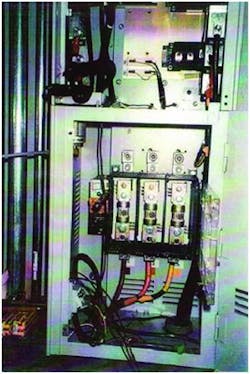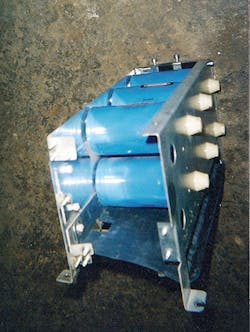The Case of the VFD Clock Culprit
The day started out like any other for one electrical technician employed by a variable-frequency drive (VFD) manufacturer. He went to work as usual, resuming a service call at a factory where he’d been working as a subcontractor all week troubleshooting an air compressor, which included a VFD to control its speed, that had been put out of service by a lightning strike. Tragically, the work day was cut short when an employee found him lying on the floor close to the panel with a head wound and not breathing. Following the accident, forensic engineers contemplated many theories — ruling them out one by one — before determining what caused the electrocution that ultimately took the life of this unsuspecting technician.
The scene
Unbeknownst to the victim, prior modifications had been made to the circuitry that controlled the compressor. Earlier, a contracted electrician had performed a “changeover” that altered the internal wiring of the air compressor so it would either be run on direct line power (480V, 3-phase, 125A per phase) or through the VFD. This work was followed up by the factory’s own electrician, who also made a modification. He “improved” the electronic clock by using the 60-Hz frequency of the line voltage to synchronize it by tapping into one of the three 480V legs of the input power. Because the current drawn by the clock was approximately 25mA, this did not cause an imbalance in the 3-phase circuit — but it did have another consequence, which will be revealed later in the article.
The accident
On the morning of the accident, the technician checked into the facility and continued working on the system, just as he’d done every day for the past week (Photo 1). A few hours later, an employee found him lying unconscious on the floor close to the panel in front of the circuit he was working on with tools next to him. The employee immediately called for emergency personnel. Upon arrival, paramedics pronounced the victim dead at the scene.
The employee told police he had pulled the victim away from the electrical circuitry as soon as he found him. In addition, the police report and witness statements all described the victim as appearing “deep purple” in color — a gruesome detail but one that nonetheless would prove to be crucial for investigators to uncover the underlying cause of his death.
Another important observation related to the large metal frame (approximately 6 in. × 6 in. × 2 ft), which contained a bank of capacitors charged to 500V and was sitting on the floor next to the VFD. It had obviously been un-screwed from the rack that held the VFD (Photo 2). Following the accident, the factory’s full-time electrician immediately opened the main breaker, which was still energized, and pulled out two fuses to deactivate the panel the technician had been working on. At that point, he also notified OSHA of the accident.
The lawsuit
The plaintiff in this case was the widow of the deceased technician. We were hired by the plaintiff’s attorney as forensic experts to determine if the accident scene was unsafe (according to normal electrical procedures) and if negligence (on the part of the company and the company’s electrician) was responsible for the victim’s death.
The investigation
We made two site visits, each time taking measurements and photos of the suspect cabinet and capacitor bank. OSHA had performed its site investigation prior to this visit. We had access to a police report, autopsy report, second autopsy report (performed at the plaintiff’s expense), OSHA report with photos, report from two cardiologists (hired by plaintiff’s attorney), and reports from several experts hired by the defendant. Considering how much evidence was available — coupled with the fact that there were so many potential electrical “suspects” — this case was somewhat unusual. Basically, any of the following suspects could have killed the technician:
1) A back-EMF from the VFD
2) An exposed 480V line
3) The capacitor bank
4) A hot circuit or sub-circuit in the electrical cabinet.
Forensic analysis
Based on the investigation, we gathered many facts relating to the electrical arrangement that helped reconstruct possible scenarios leading up to the accident. Coming up from the floor at the electric cabinet was a large diameter conduit that contained four wires — one grounded conductor and three ungrounded conductors. The circuit was rated 480V and connected in a 3-phase star arrangement. The ungrounded conductors were connected to a terminal strip block at the bottom of the cabinet. The entire block was covered with a large acrylic plastic block, and the door was designed with an automatic shutoff.
The top of the terminal block was easily accessible, but it was automatically disconnected when the door opened. Although the bottom of the terminal strip remained live at all times, to reach it, a person would have had to kneel on the floor and reach under the plastic in a fashion most people would find extremely awkward or even impossible.
The capacitor bank consisted of a metal base upon which six electrolytic capacitors (rated at 500V and 15,000 mF) were found. All capacitors had one lead tied to the metal base. Therefore, the base was a “chassis” ground, which is designed to be mounted on the metal rack with screws. When it is screwed in place, the chassis ground becomes an earth ground because the rack has a direct connection to earth.
The electric cabinet supplied a VFD connected to a very large 75-hp motor. The VFD required a clock to synchronize its output frequency (i.e., chopping frequency). The clock required a trivial amount of current to operate. The frequency of choice by the manufacturer is 60 Hz, since this is readily available from the line voltage found in most U.S. electrical systems. Using 60 Hz as a standard, many other frequencies can be generated via routine logic circuits.
From the output power of the 3-phase circuit, a single thin wire ran from one of the phases (where it made electrical contact) through a limiting resistor and to the clock. Because each phase supplied 125A — and the draw from the clock chip was limited to 25mA — there was no concern about mismatching the one phase relative to the other two. In fact, to ensure stability, a wire was run by the company electrician from the point where the input conduit came in from the floor beneath the electric cabinet. The wire tied into one of the three phases, and then went directly through the limiter and to the clock chip.
A lockout/tagout procedure governs the electric cabinet. Overhead (on the ceiling) was a disconnect that could limit all power to the electric cabinet as well as the VFD and motor (Photo 3). The problem was this disconnect was located 25 ft away from the VFD control rack and accessible only by a ladder or pole. However, if the overhead disconnect was ON and someone opened the electric cabinet’s door, then the input power from the conductor running through the conduit at the bottom of the cabinet was cut off from reaching the top of the cabinet. This feature is an automatic shutoff built into the VFD by the manufacturer.
Cause of death
Death by electrocution can occur in a variety of ways, but the most common are asphyxiation and ventricular fibrillation (VFIB). In the former, a person’s heart keeps pumping, but since he or she has exceeded the let-go current, the lungs are not able to breathe in and out. Therefore, in approximately 3 min., the victim suffocates (i.e., asphyxiation). Immediate death (within seconds) occurs due to VFIB, apnea (respiratory arrest), and secondary trauma. In this case, no findings in the autopsy report were consistent with blunt trauma, hence secondary trauma was ruled out as a possible cause of death (despite the victim’s head wound).
Because the technician appeared deeply cyanotic (purple), his heart most likely continued to function normally for nearly 3 min. (or possibly longer) while his lungs failed. This is also supported by the coroner’s report that mentions “dark blue fluid” found in his lungs.
The culprit
With the cause of death attributed to asphyxia, we looked for the source of electrical energy and the current flow geometry responsible for the victim’s death. The lesions on his left hand were consistent with electrical injury — both on a macro and micro scale. The burn marks were clearly visible, even to the non-medical eyes of witnesses and police. In addition to the shock value of the electric current, we needed to consider the entry and exit points as well as the geometry of the current flow. Finding out the exact cause of the death was important not only for closure to this sad case, but also because we needed to figure out who was genuinely responsible for the victim’s death — and consequently who should make payment to his wife and family. We considered the following scenarios:
Was it the line voltage?
Did the technician accidentally come in contact with the line voltage? Suppose he reached under the plastic acrylic plate with one hand while touching the metal cabinet frame (ground) with the other. Although this was a very difficult maneuver, we needed to rule this out. In this situation, the technician would have been touching 480V line voltage, which is certainly enough to kill him. Current would be well over the 100mA needed to produce VFIB. We ruled this out as the cause of death.
An alternative theory was that the electrical path could be from the point of contact with the left hand touching the line voltage and then going to the victim’s feet. This led to two different scenarios. If his shoes conducted well (maybe they were worn out and filled with sweat), then the victim would die of VFIB, because the 480Vs would push a great deal of current. But what if the shoes acted as insulators? If so, how much insulation did they provide?
As part of this study, we tested the victim’s shoes, and the resistance was found to be 6 to 7 million ohms. We did not rely on a simple multimeter to find this value. Instead, we hooked up a 480VAC RMS power supply to a “dummy” foot, which was weighted to half the victim’s weight. The dummy foot was conductive, and we added a layer of conducting cream to the bottom of the foot — where it touched the inside of the safety shoe worn by the victim. The shoe-foot rested on a grounded metal plate. The variation of 6 to 7 million ohms was found as we moved the dummy foot from side to side to simulate normal human motion. The maximum current measured in our test was 60 mA — certainly not enough to cause even minor discomfort.
For the sake of achieving certainty in our results, we ran a human test as well. A human wearing one of the deceased’s safety shoes with conductive cream inside had a 480V source applied to the lower leg for several minutes. A current interrupt circuit was also placed in series with the human to ensure no possible injury. The results were as predicted: Nothing happened. The maximum current was less than 50 mA, but there was a great variability in the exact value of this current as the subject moved slightly. We concluded that the feet/safety shoes were not part of the circuit that led to the technician’s death. Therefore, we concluded contact with the line voltage did not kill him.
Was it the capacitor bank?
It is significant that the only thing the technician removed from the electric cabinet before he died was the capacitor bank, which was sitting on the floor next to him. If the capacitor bank killed the victim, then the electric current would not be constant — it would be diminishing in an exponential fashion. Yet, if it remained large enough for a long enough period of time, it could be the cause of death.
The capacitor bank was actually a prime suspect. Assuming a human to have approximately 1,000 ohms of resistance, the peak current would be 500mA. But when a resistance is attached to a capacitor, the current drawn decays to zero over time. However, was the current enough to kill the technician during the time he held it? Also, would it kill via VFIB or asphyxiation? We answered this question based on evidence from the scene.
If the technician were holding the capacitor bank when it began to jolt him, he would fall, which would break the circuit. There was no evident damage to the capacitor bank’s frame from it being dropped, and all capacitors appeared to be close to fully charged when we measured the voltage across each. Similarly, if the bank was resting on the floor — and if the technician bent over and touched one of the hot leads — he would also have to touch the metal base with his other hand (not a very likely scenario). So, even if the capacitor bank could have killed the technician, the ancillary evidence did not support this theory as the mode of death. Therefore, we concluded the capacitor bank did not kill the technician.
Was it the motor’s back-EMF?
We measured the back-EMF from the motor — it exceeded 10,000V, but it lasted less than a second (approximately 50 to 100 msec). The back-EMF from the motor is caused when the motor is brought to a sudden stop — the mechanical energy of the spinning motor is fed back to the input circuitry. However, the back-EMF was not a very good suspect. Granted, there was sufficient power, but the voltage decayed so quickly that it could not have killed the technician in the manner of asphyxia.
In order to turn the motor on and off, a sequence of events must take place with the door of the electric cabinet closed. Once opened, the door automatically disconnected the line power, and any voltage/power in the motor was subject to a rapid decay. How could the technician open the door in the usual manner, remove the capacitor bank, and do all this in less than 1 sec? The bottom line is back-EMF is deadly over a very short interval. The human must already be in harm’s way when the back-EMF begins. Any delays can result in the human escaping harm. Add to this the fact that the autopsy pointed to a long death (3 min.). If the back-EMF were to have any effect on the technician, it would have had to kill him over the very short time that it had sufficient voltage to do so. Therefore, we concluded that the motor’s back-EMF did not kill the technician.
Was it the junction box?
There was a junction box located on the wall near the VFD, which was installed with the purpose of controlling the electrical architecture of the VFD arrangement. If it is wired in one mode, then the VFD operates as the manufacturer intended — line voltage goes into the bottom of the VFD and leaves/enters the air compressor. This is a series connection. In the second mode, the air compressor can operate independent of the VFD. The junction box mounted on the wall next to the VFD had no role in this accident — all attempts to find an electrical leakage at the site failed. The box was wired properly; therefore, the junction box did not kill the technician.
Was it the VFD clock wiring?
As noted earlier, a grey fuse box was powered even when the VFD disconnect was in the OFF position. Furthermore, there was still one wire leaving the grey fuse box and traveling up to service a portion of the VFD (i.e., the clock circuit). The important thing is that the VFD (or a portion of it) was powered even when the VFD was supposed to be de-energized due to the disconnect being in the OFF position. Furthermore, the VFD was powered in a fashion that would moderate the levels of current to those low values enough to cause asphyxia and cyanosis. The actual components that reduced the current flow are many, but the primary ones are: the fuses, control relays, control transformer, and circuit board controlling the VFD. The current from this “hot” wire was limited to 25mA, according to tests by multiple investigators in this case.
The grey fuse box bypassed the safety feature of the VFD-disconnect. Power was supplied to the VFD clock even when the disconnect shut the main power off.
The grey box was current limited to 25mA, which is sufficient to exceed the let-go current and kill via asphyxiation. Hence, we concluded that it was the only thing that could have killed the technician.
Ironically, the part of the VFD setup that had the lowest current and power killed the victim. It had not been subjected to the scrutiny reserved for the high power components. It did not have a lock-out, tag-out protocol that an ordinary technician could use. There was a master disconnect to the VFD, but it was on the ceiling 25 ft away.
The disconnect (on the ceiling) was placed into the OFF position the previous day — the company electrician did this in front of the technician. To do this, the electrician obtained a ladder and climbed up to reach the switch. The next morning, the electrician re-energized the circuit by turning this switch back on before the technician arrived as a favor to help him get a quick start on testing. Apparently, the electrician also had to run off and do other important jobs at the company, and could not wait for the technician that morning.
The technician began his work with the electrical cabinet “live.” The safety features built into the cabinet (we found) were sufficient to protect the technician from all dangers due to the major power being fed to the VFD, once he opened the door. But the clock circuit bypassed the “turn-off” switch of the cabinet door, and this remained energized when the accident scene was investigated.
The outcome
Based on the forensic investigation and analysis, we determined the company was responsible for the technician’s death. Its representative (a licensed electrician) bypassed a necessary safety feature on the VFD unit in order to power the clock circuit. In addition, the only “safety disconnect” switch was located 25 ft away from the VFD and accessible only by a ladder. The technician knew the power to the VFD was shut off on the evening before. He could have assumed it to be shut off the next morning. The technician may have checked all line voltages leading into the VFD with the door open. If so, he would have found all voltages to be zero. The small clock wire was easy to miss on a cursory scan of the unit by a non-electrician. Ultimately, the technician was fully capable of servicing the VFD as it was designed. Furthermore, with the help of the company’s electrician, he could have analyzed the added features in a safe manner. However, he was not capable of servicing it based on the safety violations he was not aware of.
Following is the most likely scenario that occurred on the day of this tragic accident. The technician opened the cabinet. He checked the line voltages (480V per phase when ON), and found the voltages to be zero. Hence, he assumed the power to be off. He may have had the fan motor running. But when he opened the electric cabinet, this went quiet rapidly — and any back-EMF disappeared quickly as well. He removed the capacitor bank safely. He might have performed several other tests safely. Then he probably touched a portion of the clock circuit or the wire running to it with his right hand, while his left hand rested on the metal frame of the cabinet (electric ground). At this point, his 3 min. of asphyxiation had begun.
This case was set for trial, but shortly after our report was issued, the case settled. The company accepted no blame for any wrongdoing; however, it did pay the plaintiff a sum of money. The electrician working for the company was never charged or sued. A secrecy agreement precluded anyone but the company management and the plaintiff from knowing the exact amount of money paid out. No lawsuit was brought against the manufacturer of the VFD or the service company that employed the technician.
Patel is presently a freelance consultant and instructor at the University of Bridgeport. He can be reached at [email protected]. Hmurcik is a consultant at Lawrence V. Hmurcik, LLC. He can be reached at [email protected].



